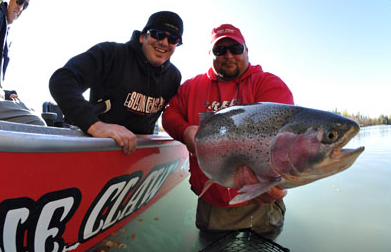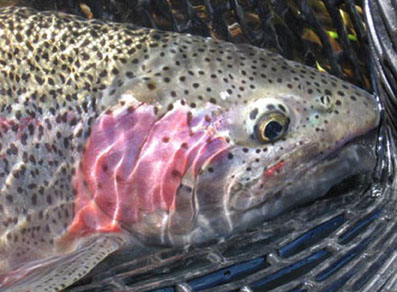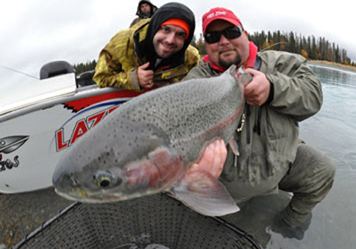Stripes and Spots Leave a reply
By John Whitlatch. Two words cross my mind on daily basis, stripes and spots. These unmistakable markings make Rainbow Trout revered by sport fishermen around the world. Like your trusty and loyal Labrador retriever is consumed by a tennis ball, I am consumed by visions of shimmering chrome Rainbows breaking the surface and doing back flips as my fly line comes tight on opening day.
In winter months I find myself counting down the days Alaska’s legendary Kenai River Rainbow season opens once again. Tossing and turning through one sleepless night each day getting worse and worse. I find that the sun filled days of King Salmon fishing distract me. My nights, however, get longer than ever before as season comes just around the corner. Unfortunately this years King season is a little different. A closure on the Kenai Kings has left me sitting in my yard staring at my boats with nowhere to go and nothing to keep from dreaming of the strips & spots.
night each day getting worse and worse. I find that the sun filled days of King Salmon fishing distract me. My nights, however, get longer than ever before as season comes just around the corner. Unfortunately this years King season is a little different. A closure on the Kenai Kings has left me sitting in my yard staring at my boats with nowhere to go and nothing to keep from dreaming of the strips & spots.
Knowing that the Trout season is almost here I begin tying up gear…lots of gear!
Trout gear on the Kenai is far from ordinary. When people ask me how to fish Trout on the Kenai I usually answer by saying “this river is simple in its complexity”. It’s very simple for even the most novice fisherman to be successful on the Kenai fishing for Trout. In my opinion it is one of the last best kept secrets the Trout fishing world has to offer. There are hoards of people that descend on the Kenai every summer to chase the mighty Salmon. Most of these people don’t care or don’t realize that monster Rainbows prowl these same waters. While it is easy to be successful and have 50-100 fish days every day, you had better be dialed in if you want to catch monster Trout. These complex big Trout are educated, very educated. Only the right drift, at the right speed, with the perfect rig will fool the largest Trout. All five species of Pacific Salmon return to spawn in the Kenai River. Chinook, Silvers, Sockeye, and a hand full of Chum return every year depositing eggs and flesh in the river system. Every other year Pink salmon return to provide an entirely different food source for the monster native Rainbows. When the Salmon arrive the add many variables to the river including; spawn timing, egg size, egg color, and egg locations. The Salmon food source can be just on element of the Trout formula. Combining the food source with water depth, clarity, and temperature can make an intimidating combination. As with any worth while endeavor, and with a little perseverance, the Kenai will reward the dedicated fisherman with a trophy Rainbow of legendary status. I make a living at getting the big fish to make mistakes. Here are the basics for the simple hand to get you started.

Fly fishing is the preferred method for Trout fishing the Kenai. Fly fishing may not be the most effective way to fish the Kenai but it is a time honored tradition amongst trout fisherman and still the most popular here on the Kenai. I prefer a 10’ 7 wt. Wright and McGill rod to tame these fish, even from a boat. They are big and strong, anything less and you are likely to end of with a hand full of toothpicks that used to be your 6 wt. I rig them with an 8 wt. Rio Steel Header line and cut the last 10 ft off of it. Cutting the end off will help with the large indicator and unique cast we use here while fishing from a boat. From my fly line I tie on a 10 in. 20 lb. monofilament section with a large Frog Hair strike indicator. Then I use 9’-10’ of 12 lb Seaguar fluorocarbon leader. At the end of the leader I like to tie about a 20 inch tippet with either 8lb or 6lb Seaguar fluorocarbon. Finally at the end my line my fly of choice for the day with a couple of split shot at the knot from the leader to tippet. With this setup any angler can be catching fish in a jiffy.
For those of you who do not fly fish, there is an alternative, float fishing. Some years ago I took some “old school” technology and made it a Kenai River Trout slaying machine. The float rod has really gained popularity the last few years with many professional guides. I use the 11’ 6” Wright and McGill float rods and their Sabolos 2500 reels spooled with 20lb. Power Pro braid. Rigging is simple. Tie a nail knot on your line with a piece of 30lb mono for a float stop. Slide on a Drennan slip float or a balsa float of your choice onto your line. Then attach your swivel below that. Place (2) 3/0 split shot on the braid above the swivel to help the line feed through the slip float. From there I use about 4’ of 12lb. Seaguar fluorocarbon. Next I add 20” of 6 or 8lb Seaguar tippet again. Then I attach 1 or 2 small split shot above this knot to get your fly down and you are fishing. Cast upstream and hold your rod high to keep your line off the water. Leave your bail open with your hand over the spool. Let the line feed out with the current keeping a natural drift until your float goes down. When the float is down flip your bail closed and SET THE HOOK HARD!
The next method and perhaps the most deadly method is Center-Pinning. My better half appropriately dubbed it a bike with no brakes. Like the float rod the Center-Pin rod is very long. Center-Pins range from 11-15’ in length with a reel that resembles a fly reel but with no drag. The drag is done all by hand, “mono e mono”. I spool my center-pin reels with straight 12lb Suffix high visible orange line. The Suffix line is Hydrophobic, meaning it floats and is highly resistant to twist. It’s by far the best line I have found for the center-pin. I rig it with a fixed float on the Kenai. With the extra length of the rod and the style of casting there is no need for a slider. I prefer a 5.5 gram Raven float. Below the float I tie a micro swivel and about 8 ft of 10 lb Seaguar Fluorocarbon for my shot line. I space out small shot along the length of this section of line to get my whole line sinking evenly and naturally along its length. Then another micro swivel with my 20 inches of 8 lb Seaguar tippet attached and my favorite fly or bead at the end. Fishing the Center-Pin is the same process as the float rod. Cast up stream and let the line roll off the free spooling reel until the float goes down. With a drag free, natural drift, Center-pining is unmatched and translates into more fish.
I won’t spend much time on the last two methods employed on the Kenai except to say this. If you are lacking skill you may pull plugs or drag shrimp for these fish and be successful as well. I recommend avoiding treble hooks and shrimp due to their high motility rates. These fish are truly special trophies, something I hold dear to my heart, and there is no quicker way to scar them or kill them than hooking them on a plug with bait and treble hooks.

Trout season on the Kenai officially opened on June 11th. It didn’t disappoint with some magnum rainbow hungry after just getting over the recent spawn making unusual mistakes. So it’s back to the grind now, guiding tourists chasing the mighty Kenai King Salmon for another month and a half until the trout season really ramps up in August. The fall is when these fish really grow to enormous proportions feeding on salmon spawn and rotting carcasses all summer. So while I dearly love salmon fishing stripes & spots are always in the back of my mind. I know these magnificent Rainbows, the Kenai’s secret treasure are waiting and they will be ready for battle when king season closes at 12:01 a.m. August 1st. Until then I will be dreaming of a 35 incher to do back flips for me this fall.
John Whitlatch
Reel Adventures
www.kenaireeladventures.com
907.252.7335

